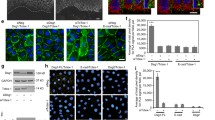Summary
Small trypsinized explants from ventral skin of frogs (Rana esculenta) were maintained in culture for 4 days during which a newly formed epithelium differentiated along the cut edges of the dermis. During the first 6 h adjacent cells produced numerous interdigitating lamellipodia. After 2 days, epithelial polarity was restored by the formation of zonulae occludentes and the epithelial cells were joined by a few small newly formed desmosomes and by numerous interdigitations. Bipartite junctional complexes consisting of a zonula occludens, followed by a series of typical desmosomes, and characteristic of adult frog epidermis were formed only after 4 days. When cultured in the presence of an inhibitor of protein synthesis (cycloheximide) the trypsinized epidermis no longer formed desmosomes. Therefore pools of one or more crucial desmosomal proteins must be very low or non-existent. However, cycloheximide did not prevent the formation of cell contact specializations, consisting of a highly developed system of complex lamellar interdigitations, between adjacent cells.
Similar content being viewed by others
References
Abercrombie M, Heaysman JEM, Pegrum SM (1970) The locomotion of fibroblasts in culture. II: Ruffling. Exp Cell Res 60:437–444
Abercrombie M, Heaysman JEM, Pegrum SM (1971) The locomotion of fibroblasts in culture. IV: Electron microscopy of the leading lamella. Exp Cell Res 67:359–367
Bereiter-Hahn J, Strohmeier R, Kunzenbacher I, Beck K, Voth M (1981) Locomotion of Xenopus epidermis cells in primary culture. J Cell Sci 52:289–311
Borysenko JZ, Revel JP (1973) Experimental manipulation of desmosome structure. Am J Anat 137:403–422
Choi AHC, Siu CH (1987) Filopodia are enriched in a cell cohesion molecule of Mr 80000 and participate in cell-cell contact formation in Dictyostelium discoideum. J Cell Biol 104:1375–1387
Denèfle JP (1973) Méthode de culture organotypique de la peau de grenouille adulte (Rana esculenta). J Microsc 17:97–102
Denèfle JP, Lechaire JP (1984) Epithelial locomotion and differentiation in frog skin cultures. Tissue Cell 16:499–517
Denèfle JP, Goudeau H, Lechaire JP (1983) Influence of a transepithelial NaCl gradient on the moulting cycle, keratinization and active sodium transport of isolated frog skin cultured with or without aldosterone. Roux's Arch Dev Biol 192:234–247
Gibbins JR (1973) Epithelial migration in organ culture. Role of protein synthesis as determined by metabolic inhibitors. Exp Cell Res 80:281–290
Kunzenbacher I, Bereiter-Hahn J, Osborn M, Weber K (1982) Dynamics of the cytoskeleton of epidermal cells in situ and in culture. Cell Tissue Res 222:445–457
Lechaire JP (1984) Locomotion épithéliale et formation des jonctions intercellulaires au cours de l'épibolie en culture organotypisque de l'épithélium cutané chez la grenouille verte. Thèse de 3e cycle Université Paris VI
Lentz TL, Trinkaus JP (1971) Differentiation of the junctional complex of surface cells in the developing Fundulus blastoderm. J Cell Biol 48:455–472
Levenson R, Housman D (1979) Developmental program of murine erythroleukemia cells. Effects of the inhibition of protein synthesis. J Cell Biol 82:715–725
Morejohn LC, Pratley JN (1979) Differential effects of trypsin on the epidermis of Rana catesbeiana: observations on differentiating junctions and cytoskeletons. Cell Tissue Res 198:349–362
Obrig TG, Culp WJ, McKeehnan WL, Hardesty B (1971) The mechanism by which cycloheximide and related glutarimide antibiotics inhibit peptide synthesis on reticulocyte ribosomes. J Biol Chem 246:174–181
Overton J (1962) Desmosome development in normal and reassociated cells in early chick blastoderm. Dev Biol 4:532–548
Overton J (1968) The fate of desmosomes in trypsinized tissue. J Exp Zool 168:203–214
Overton J, Desalle R (1980) Control of desmosome formation in aggregating embryonic chick cells. Dev Biol 75:168–176
Radice GP (1980a) The spreading of epithelial cells during wound closure in Xenopus laevis. Dev Biol 76:26–46
Radice GP (1980b) Locomotion and cell substratum contacts of Xenopus cells in vitro and in situ. J Cell Sci 44:201–223
Trowell OA (1954) A modified technique for organ culture in vitro. Exp Cell Res 6:246
Venable JH, Coggeshall R (1966) A simple lead citrate stain for use in electron microscopy. J Cell Biol 25:407–408
Wolf K, Quimby MC (1964) Amphibian cell cultures. Permanent cell line from the bullfrog (Rana catesbeiana). Science 144:1578–1580
Author information
Authors and Affiliations
Rights and permissions
About this article
Cite this article
Lechaire, JP. Formation of desmosomes and other contact specializations in cultured skin of the frog (Rana esculenta). Cell Tissue Res. 252, 157–163 (1988). https://doi.org/10.1007/BF00213837
Accepted:
Issue Date:
DOI: https://doi.org/10.1007/BF00213837




